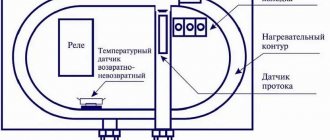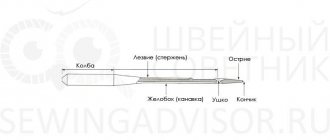Home / Boilers
Back
Published: November 23, 2019
Reading time: 3 min
3
5936
Owners of water heating boilers quite often come across information about the magnesium anode, but, as a rule, only a few know what the anode for the boiler looks like and what role it plays.
In short, it can be noted that the primary task of a magnesium electrode is considered to be anti-corrosion protection of the internal surfaces of the tank.
Dismantled anode. Photo source: tehnika.expert
- 1 Purpose of a magnesium anode for a water heater
- 2 Operating principle
- 3 Types of anodes 3.1 Magnesium
- 3.2 Titanium
- 3.3 Aluminum
What is an anode for a water heater
To understand what an anode is and how this part works, it is necessary to imagine the electrochemical processes that occur inside the boiler. In an aqueous environment, the magnesium rod becomes a positive (corrodable) element, and the walls of the heater container become negative.
Purpose of the anode for a water heater
What is an anode for?
- active protection of the tank from corrosion;
- prevention of cracking of the enamel coating;
- increasing the service life of equipment (heating elements, boiler tank walls);
- loosening the layer of scale that settles during operation of the heater;
Anode rod design
A standard water heater anode is a threaded rod coated with a layer of magnesium alloy. The thickness of the coating is about 10 mm. The most common anode material is AZ63 alloy. Analogues of this tread alloy are N-1, MP-1 and MP-2. Magnesium is applied by casting into a chill mold.
The magnesium anode is made of a rod, inside of which there is a threaded steel pin.
Anode designs for different boiler models differ in the length and diameter of the rod itself, as well as the parameters of the pin, which is used to secure the part inside the tank.
Some modern models of water heaters are equipped with flexible plastic rods filled with magnesium granules.
This design facilitates installation and allows you to restore the functions of the anode by adding granules.
How does a magnesium anode rod work?
In the absence of an anode, galvanic couples are formed inside a metal container with water, which lead to the gradual destruction of the walls. If you place a part made of a more active material than iron into this system, it will have a much higher potential for reaction. In this case, the anode will be an additional rod, and the cathode, on which cations of the active metal will be deposited, will be the walls of the boiler.
In addition to corrosion, scale is also a problem when servicing the device. A layer of carbonate salts settles not only on the walls of the container, but also on the element that heats the water. With continuously occurring electrolysis and the formation of magnesium salts, the scale becomes more porous, soft and loose, which makes it easy to clean it from the surface of the heating element and tank.
After a year of operation, corrosion is visible on the magnesium anode - oxides that gradually destroy the electrode.
When to change the boiler sacrificial anode
After a year of operation, corrosion is visible on the surface of the magnesium anode - oxides, which crumble and gradually dissolve, destroy the electrode. As a result, the length and diameter of the anode decreased.
As erosion progresses, the anodes must be replaced regularly . The criteria by which the need to replace the anode is determined are usually specified in the factory instructions. Manufacturers of electric water heaters recommend that after one year from the start of operation, inspect and assess the degree of wear of the anode and the amount of scale deposits on the heating elements. Based on the assessment results, the frequency of anode replacement and descaling is determined.
The sacrificial protection anode has a slight effect on the formation of scale on the heating elements of the water heater. An increase in the intensity of electrochemical processes on the metal surface contributes to some loosening of the scale layer. Stone made from hardness salts becomes less dense and is easier to separate from the metal.
What other types of anodes are there?
Aluminum and titanium anodes are also installed in water heaters. They may differ from magnesium in cost and configuration.
Titanium
The titanium anode is connected to a voltage source, so it does not corrode like magnesium. The part does not need to be replaced, since the tank is protected due to external current parameters.
The titanium anode is compact and easy to use.
When connecting a non-destructive electrode, the frequency of boiler maintenance increases to 1-1.5 years.
Aluminum
An aluminum anode has the same operating principle as a magnesium anode. Due to the lower activity, the protective effect extends to a smaller area of the base metal. To prevent corrosion of the entire tank, it is necessary to install an anode with a large length and protector thickness. Several aluminum electrodes are placed in large boilers and boilers at once.
The aluminum anode in a water heater typically lasts three to five years.
How does the anode work in a water heater and what is it for?
The magnesium anode in a water heater is a metal cylinder made of the named material, which is designed to attract heavy salts from the water in order to increase the service life of the device.
This is a consumable item and needs to be changed periodically. This part wears out so that the rest of the housing and heater continue to function properly.
The walls of the heater deteriorate because the electrochemical potential of the material is lower than that of the other components used in the assembly. Therefore, without an anode, scale salts settle precisely on the inner layer of the tank, corroding the surface. The potential of magnesium is even lower.
The inner insert attracts destructive sediment towards itself. Here's how an installed magnesium anode works in a water heater.
Of all the metals that can provide such protection against corrosion, magnesium is the most accessible. It is used in production without raising the price of the finished product. At the same time, periodic replacement of such a part will cost the owners inexpensively.
How to determine whether an element can be replaced
Boiler manufacturers recommend scheduled maintenance of the device once every 6-9 months. If deep potholes appear on the surface of the corroded rod or it has greatly decreased in size, then it needs to be replaced.
The average service life of the active electrode is 9-12 months.
It is recommended to replace the anode when more than 70% of the coating has been depleted. If there is no electrode, it is not recommended to turn on the heater. During scheduled maintenance, it is also recommended to thoroughly clean the surface of the heating element and tank from a layer of scale.
Regular cleaning of the boiler will ensure its long-term operation.
Signs of heating element contamination are:
- the appearance of a quiet hiss during operation;
- frequent turning on and off of the device;
- slow water heating.
How to extend the life of the anode
The service life of the anode depends on the specific use of the boiler, the hardness of the water and the quality of the alloy itself, which is used to protect the tank. To extend its service life, you need to:
- turn on the water heater in economy mode;
- install original anodes when servicing the device;
- use flow filters to purify water from carbonate salts, chlorine, dirt and other impurities.
For consultation and purchase of a filter, please contact.
It is important to note that the dissolution of the anode is a normal process. The corrosion that occurs is the main sign that the heating element and tank are protected from destruction. If the magnesium rod has significantly decreased in size or the boiler malfunctions, you need to clean the container and replace the anode.
If the anode is half worn out, it will need to be replaced soon.
Removing the element in the water heater
The magnesium electrode is a consumable item, so you need to check its condition regularly. To diagnose and replace a part you must:
- Turn off the boiler and close the valve.
- Drain the water through the tap or check valve.
- Disconnect the hoses and remove the casing from the bottom of the tank. In some heater models (for example, with a strip and a nut), the lower part can only be removed in an inverted position, so the device will have to be completely removed from the wall.
- Remove the boiler control unit and flange, having first taken a photo of the location of the wires. If the flange is secured with a 55 mm nut, then you need to carefully turn it counterclockwise using an adjustable or hub wrench.
- Get the heating element. A thick layer of deposits can lock it tightly into the groove, so it needs to be slightly rocked from side to side before dismantling.
- Remove the magnesium anode from the socket. Inspect its surface and measure the thickness of the residual active layer. If wear is more than 60-70%, replace the part with a new one.
- Reassemble the water heater in reverse order.
When servicing the boiler, it is necessary to clean the tank and heating element from scale.
Myths about magnesium rod
The proliferation of boilers with anode protection has led to the emergence of many myths. The main subject of debate is its actual effectiveness in conditions of high water hardness and in a stainless tank.
Does it really help with scale?
Scale is formed from carbonate salts found in tap water. The concentration of these compounds determines its hardness. The presence of magnesium cannot affect this process, since an acidic environment is needed to dissolve scale.
However, the mixture of calcium and magnesium salts, which is formed during the electrolysis process, turns out to be looser than the scale that settles in the absence of an anode.
Do I need a stainless steel tank?
Stainless steels, which contain nickel and chromium, have increased corrosion resistance and do not rust even with constant contact with water and oxygen. In addition, the boiler walls are additionally protected with anti-corrosion paints and enamels.
Magnesium anode can be installed in stainless steel boilers.
However, magnesium anodes are also installed in stainless steel tanks. This is due to the following reasons:
- the composition of the alloy may be uneven, which leads to the formation of galvanic couples and pitting (pitting) corrosion;
- the boiler tank is not solid, but welded, and the joint is more easily destroyed;
- Due to the expansion of the metal during cyclic heating and cooling, the anti-corrosion coating gradually cracks.
Magnesium is much more active than steel of any composition, therefore, with an uneven distribution of alloying elements, stainless alloys do not form galvanic couples. The metal ions that are released during the reaction partially fill the cracks in the enamel, preventing the tank from coming into contact with water.
Is it harmful to health?
Magnesium carbonates do not cause harm or benefit to the health of people who use hot water for domestic purposes. Since the amount of these salts is insignificant, they have little effect on the level of water hardness.
The occurrence of corrosion
Since modern water heaters of the brands Ariston, Electrolux, Thermex and others are made of stainless steel, many people wonder where corrosion . There are two factors that can negate all the advantages of stainless steel in boilers.
First of all, food grade stainless steel is
not a very resistant material . It can withstand hard and salty water, but only for a limited time, no more than a year. If truly high-quality stainless steel were used to make boilers, then the cost of such devices would be prohibitive and only a few would be able to afford them. But such water heaters are affordable for many people and provide hot water in almost every home.











